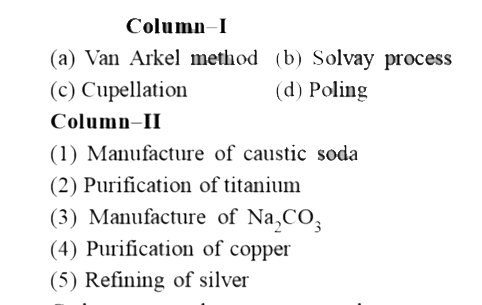Match the materials listed in the column−I with type of silicates listed in column −II , and select the correct answer using the code given below the list :
Column−IColumn−II(a)Spondumene(p)Two dimensional sheet silicates(b)Throteveitite(q)Pyrosilicates(c)Kaolin(r)Chain silicates(d)Quartz(e)Three dimensional sheet silicates.
A
(a)(b)(c)(d)rqps
B
(a)(b)(c)(d)qrsp
C
(a)(b)(c)(d)rpqs
D
(a)(b)(c)(d)sqpr
Video Solution
Text Solution
The correct Answer is:1
(a) In case of simple chains two corners of each tetrahedron are shared & they form a long chain of tetrahedron. Their general formula is also same as the cyclic silicates i.e.(SiO3)2n−n
Similarly, double chain silicates can be drawn in which two simple chains are joined together by shared oxygen. Such compounds are also known as amphiboles. The amphiboles. The asbestos mierals is a well known example of double chain silicates. The anions of double chain silicates have general formula (Si4O11)6−n
e.g., Synthetic silicates (Li2SiO3,Na2SiO3), Spondumene (LiAl(SiO3)2),
(b) In pyrosilicates two tetrahedral units are joined by sharing by sharing oxygent at one corner thereby giving [Si2O7]6− units e.g. Theorteveitite (Sc2Si2O7), Hemimorphite (Zn3(Si2O7)Zn(OH)2H2O).
(c)In two dimensional sheet silicates, three oxygen atoms of each tetrahedral are shared with adjacent SiO4−4 tetrahedrals. Such sharing forms two dimension sheet structure with general formula (Si2O5)2n−n e.g. Talc (Mg(Si2O5)2Mg(OH)2,KaolinAl2(OH)4(Si2O5).
(d) Three dimensional silicates involve all four oxygen atom in sharing with adjacent SiO4−4 tetrahedral units. e.q. Quartz, Tridymite, Crystobalite, Feldspar, Zeolite and Ultramarines.
|
Topper's Solved these Questions
Similar Questions
Knowledge Check
Match column–I with column–II and select the correct answer using the codes given below the lists:
 Aa→2,b→1,c→3,d→4Ba→4,b→3,c→2,d→5Ca→2,b→3,c→5,d→4Da→5,b→1,c→3,d→4
Aa→2,b→1,c→3,d→4Ba→4,b→3,c→2,d→5Ca→2,b→3,c→5,d→4Da→5,b→1,c→3,d→4Match column–I and column–II and select the correct answer using the codes given below the lists:
 AI–(3) II–(1), III–(4), IV–(2)BI–(4) II–(2), III–(3), IV–(1)CI–(3) II–(2), III–(4), IV–(1)DI–(4) II–(1), III–(3), IV–(2)
AI–(3) II–(1), III–(4), IV–(2)BI–(4) II–(2), III–(3), IV–(1)CI–(3) II–(2), III–(4), IV–(1)DI–(4) II–(1), III–(3), IV–(2)Match Column I with Column II and select the correct answer using the codes given below
 AA-2, B-4, C-3, D-1BA-3, B-4, C-2, D-1CA-, B-4, C-1, D-3DA-2, B-3, C-1, D-4
AA-2, B-4, C-3, D-1BA-3, B-4, C-2, D-1CA-, B-4, C-1, D-3DA-2, B-3, C-1, D-4
Match column I with column II and select the correct answer using the code given below the columns:


View SolutionMatch column I with column II and select the correct answer using the code given below the columns:

View SolutionMatch column I with column II and select the correct answer using the code given below the columns:

View SolutionMatch column I with column II and select the correct answer using the code given below the columns:

View SolutionMatch column I with column II and select the correct answer using the code given below the columns:

View Solution



